Women in the modern world live and work, often in a frantic pace along with men. This inevitably affected the appearance of the fair sex and women's fashion.
Therefore, the main subject of the wardrobe were pants of all kinds and stripes, which women liked for their convenience and wearing comfort. At the same time, the fair sex strives to remain feminine and attractive - then pants of a unique cut, called a skirt, trousers, come to the rescue.
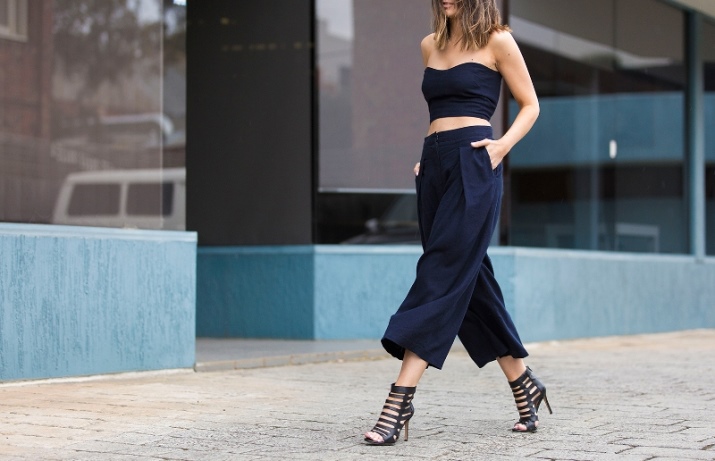
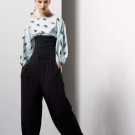
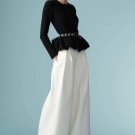


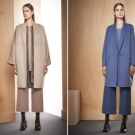
What is a skirt pants?
An amazingly convenient style of this clothing allows women not to puzzle over what to wear - a skirt or trousers, since culottes (the professional name of this wardrobe item) combine the virtues of both of them.
They allow you to make the image feminine and stylish, while leaving it comfortable. Due to the free cut, tight-fitting waist and expanding down from the upper thigh, this style of trousers can be worn by women with absolutely any type of figure - imperfections will be reliably hidden from prying eyes.
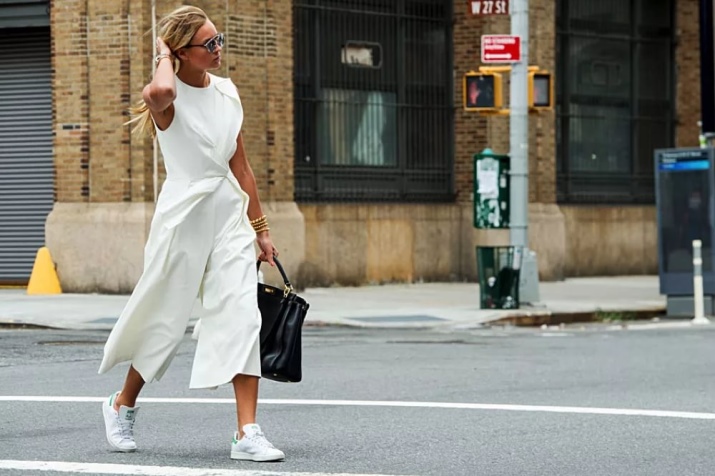
Another advantage of such clothes is its versatility - you can wear such a skirt at any time of the year and in any weather - you just need to carefully approach the choice of material: in winter it will be dense warm wool, and in summer - light fabrics flowing in the wind.
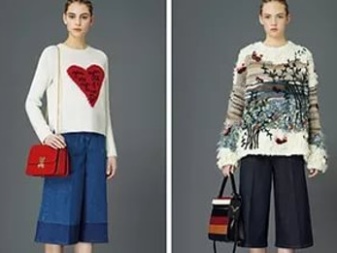
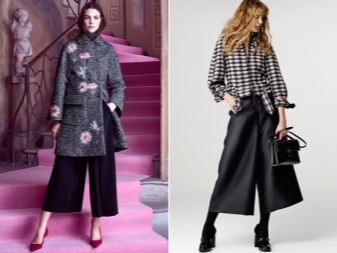
This unusual design first appeared in the thirties of the nineteenth century in Holland. Then the idea of a woman wearing things reminiscent of men seemed unthinkable.According to legend, one Dutch woman loved cycling, and making them in a dress was extremely uncomfortable. Then she found a way out - created unusually wide trousers that looked like a skirt from the side.
Since then, the appearance of this type of clothing has not changed much - variations were created with only minor innovations.
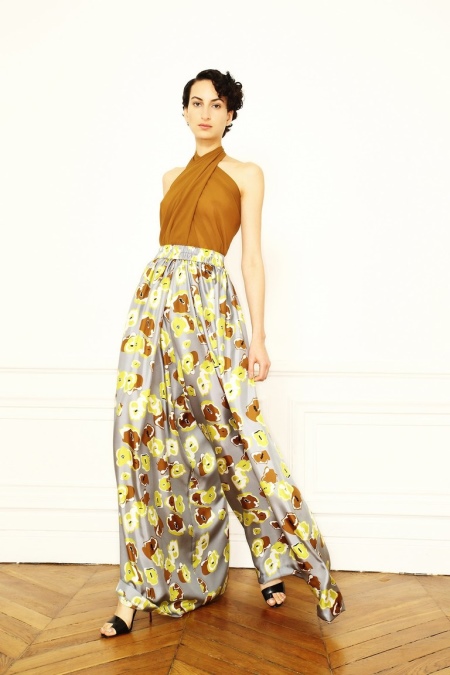
Step-by-step instruction for creating a pattern
In the modern world there are a huge number of specialized magazines in which you can find the necessary patterns. When using a ready-made pattern, the sewing process is greatly simplified, but you need to make adjustments depending on the features of the figure.
To create a pattern of such original trousers, you will need to find a pattern of an ordinary straight skirt, and with it you can easily create culottes of any style and length. There really are a lot of similarities between these two variations of women's clothing, and understanding them will help to master the creation of fashionable wide trousers without problems.
We list only the measurements that are needed to build a drawing of the future skirt. See photo below. This is a guide for those who want to build a straight skirt pattern themselves.

We turn again to modeling fashionable culottes. On the pattern of a straight skirt, you need to make some changes. You need to draw a step slice. The following measurements will be required: seat height (BC), hip circumference (AB). The photo shows how to take such measurements.
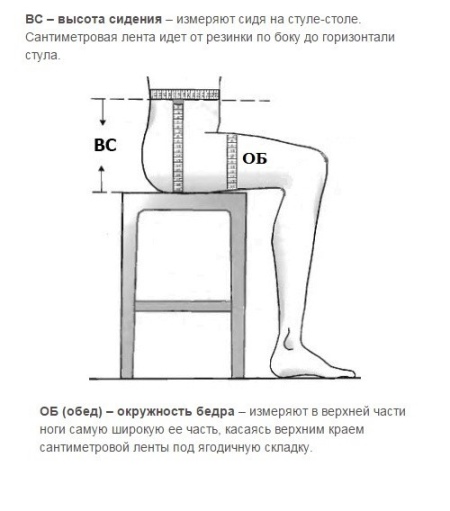
Next draw. Consider the front panel:
- From point 1 down, we postpone the measurement of BC + (0-2) and put point 2.
- From mark 2 up, set aside 1/8 RP - 2 and set point 4.
- From mark 2 to the left, you need to draw a segment equal to 1/8 OB - 2. Set point 3.
- A straight line connects the points 3.4. A bisector from the top of the corner bisects it.
- The bisector is divided into equal parts. Through the middle of the bisector draw a smooth line. The stepping slice is ready.
On the next pattern, from point 5 down we postpone the segment BC + (0-2), we get the mark 6. From point 6 we draw a segment equal to 1/8 OB + 2. It turns out point 7. The next step is similar to the previous one, with one correction. The bisector is divided into parts: ½ and ½ +0.5 cm. Visually it is better to look at the photo.
To the skirt, trousers need another belt. It is cut out in a rectangle: where the width is 4-6 cm, and the length is equal to the circumference of the waist. Culottes will sit better on the waist if the belt inside is duplicated with non-woven fabric.

Oblique modeling
Modeling oblique involves the location of the warp threads at an angle of 45 degrees. Due to this position, the material becomes very plastic and elastic, it can be stretched. Variants of tailoring the sun and the sun are made just in this way. Cutting along the oblique helps create a very feminine silhouette, due to the fact that all the bends of the body are gently emphasized, but at the same time freedom of movement is preserved.
To create products that are cut in this way, much more fabric is required. However, it’s worth it - clothes sewn obliquely visually slim and hide flaws.
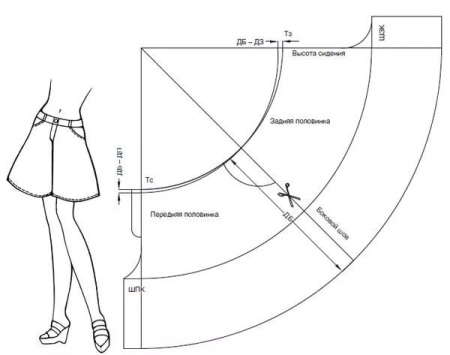
Fabric selection
Previously, thick, heavy fabrics were used for sewing culottes, and the silhouette was created straight and wide, with a length of up to the ground. Now most designers choose light, flowing fabrics. Summer models are created from cotton materials, but they, with all the environmental friendliness and comfort of socks, have one significant drawback - they wrinkle very easily and lose their presentable appearance. Knitted materials with a small addition of synthetics are devoid of these drawbacks.
Leather models also appear. For lovers of country style and jeans, denim skirts appeared. Such a variety of fabrics allows you to choose a thing that is close in style to what you like, but at the same time make the daily image original and memorable. It is amazing that any materials are really suitable for such a wardrobe item: stylishly and organically fit into the image of both trousers from air chiffon and culottes from a harsh raincoat fabric.The choice of fabric depends on where this skirt is supposed to be worn - at the office during the working hours of the day, at an official event or at a summer picnic.
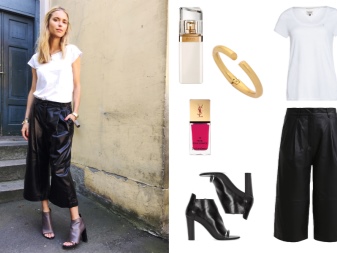
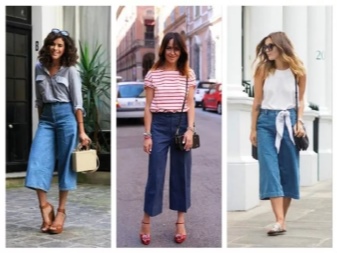
The choice of material affects the choice of model, which is better to create from it:
- Based on a dense, heavy material, it is possible to sew culottes with numerous folds diverging from the line of the hips. This model will be suitable for business meetings or walks in the city.
- From translucent drapery fabrics, models are created for romantic dates and summer trips. The constructive basis for them is a cut like the sun or a half sun with a smooth expansion downward.
When choosing a fabric, you need to think in advance how the future product will look. For example, too heavy dense fabric will not hold folds well, and to make them better visible, you should choose a plain material.
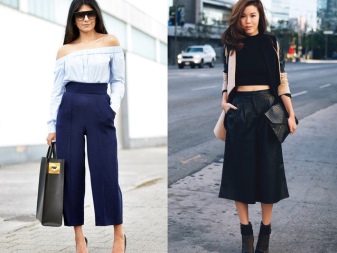
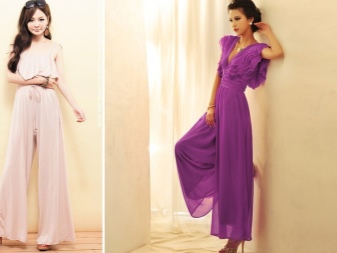
Popular patterns of culottes and patterns
There is a huge variety of different models of pants of this cut, allowing each woman to choose the model that will look perfect on her. They vary in length, degree of flare, the number of folds.
It is optimal to choose the type of trousers, focusing on your type of figure:
- For overweight women, pants will be ankle-length or floor-length pants. The flared canvas perfectly hides the imperfections of the legs and visually slim the figure, also it levels the fullness of the hips and the missing waist.
- Maxi length is suitable for girls with narrow hips - they are better off choosing a model with a smell. A significant nuance that should be remembered when choosing a long flared skirt is that it is recommended to wear it with shoes with heels, otherwise there is a risk of visually weighting the figure and reducing growth.

- Midi length skirt suits tall women with slim legs, as flared trousers up to the middle of the lower leg can additionally conceal growth and upset proportions.
- A wide skirt just below the knee will help visually adjust the silhouette of girls with a figure of the “inverted triangle” type. She will competently balance the massive upper body, making the figure feminine and harmonious.

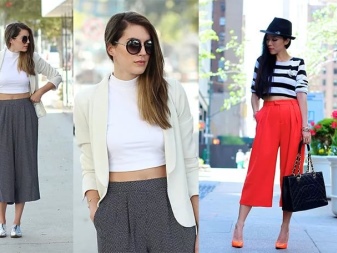
- Short culottes will appeal to young girls. They are great for discos, parties with friends, going to the movies.
- The model with folds on an elastic band is perfect for walking in nature or along the seashore, in such trousers it will be convenient and comfortable. The peculiarity of the pattern of pants on an elastic band is the absence of tucks in the waist and a one-piece belt.
- In addition, designers create culottes with a low or high waist, decorate them with cuts and buttons, often supplemented with hidden pockets.


How to cut?
We lay out the finished cut-out pattern on the fabric. The fabric folds in half with the front side inward. The drawing is laid out in the direction of the shared thread. We stab with tailor pins and draw on the fabric along the contour. It should make a reservation about tucks. Tucks are drawn, but not cut.
The full outline of the culottes is circled again with allowances for the seams and cut. Seam allowances from the bottom of the leg are taken 3-4 cm. This allowance is made taking into account the shrinkage of the fabric.
Nuances when cutting:
- Seam allowances for cutting are the same for any fabric - 1-1.5 cm.
- Tucks will then need to be sewn up. This is done to better fit the product at the waist.
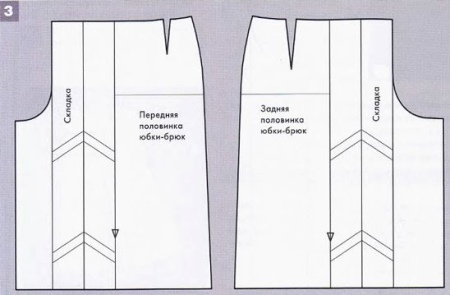
Sewing technology
The finished parts of the trouser skirt are ready, we can start sewing. There should be 5 pcs.: Rear panel 2 pcs., Front panel - 2 pcs., Belt - 1 pc. Accuracy and adherence to safety regulations will not be amiss.
Scissors should be kept away so that when basting and sewing, do not accidentally cut the finished parts:
- For beginner needlewomen, you can lay out copy snares. They will help to sweep the product correctly and to lay out exactly the basting.
- First of all, you need to sew tucks on two panels of the skirt.
- We sew a step cut on the skirt of the trousers.
- On the side or on the back panel you need to sew in a zipper.
- We sweep and sew the side seams.
- Pantaloons are almost ready.
- It remains to grind the belt, make a buttonhole and sew the button. The belt folds doubly, the interlining should fit inside.
- Do not forget to process the bottom of the trousers in any of the known ways.
- Thus, it is not difficult to sew a skirt-pants, even without having a special pattern for this and a lot of experience.
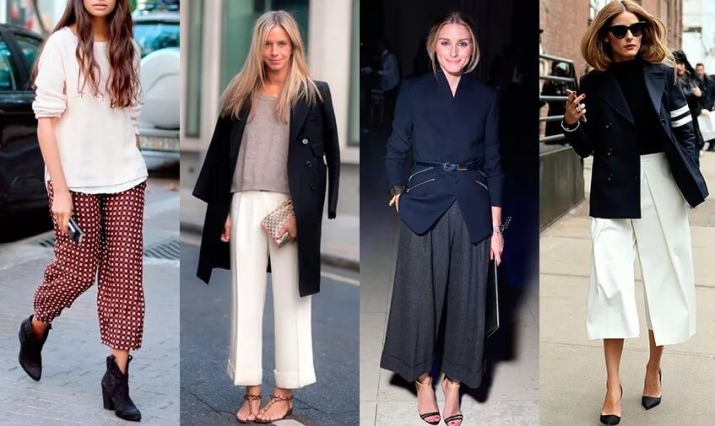
Workshop tailoring a culott with a smell for beginners
Pantaloons come in many styles. Culottes with a smell - a trouser skirt that can be worn at any event: a gala reception, meeting with friends or studying at the university. We will sew the culottes shown in the photo. But! Instead of a bodice there will be a belt.
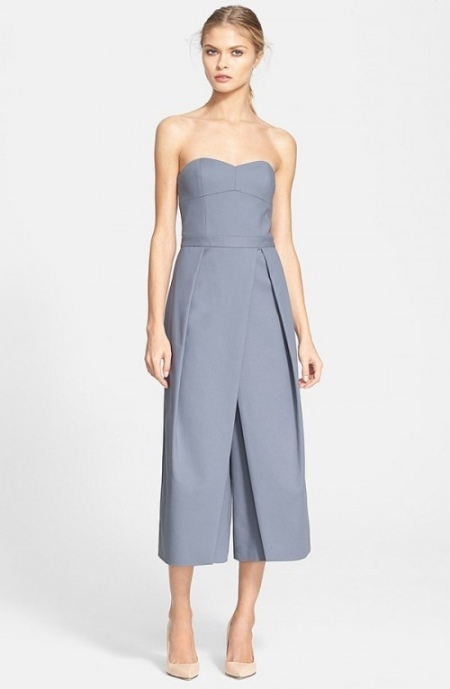
To create a trouser skirt, you will need: lightning, a small piece of non-woven fabric for the belt, threads and tools: needles, pins, scissors, a pencil and a ruler. Then the fabric folds in half, face inward. Patterns of trouser panels are superimposed so that the shared thread of the fabric is parallel to the step line.
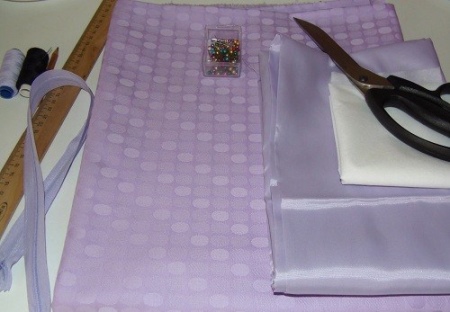
We simulate a ready-made pattern of culottes. The back panel remains unchanged. We are interested in the second pattern. Look at the photo. There are folds on the trousers. They then imitate the smell.
On the front panel, you need to draw the width of the folds. The width of the spare part is equal to the distance between 2 tucks. From the beginning of the tuck to the left, you need to postpone 2 cm and draw a straight line to the end of the product.
Now we measure the distance from the right end of the tuck to the step cut. According to the following formula, we obtain the desired odor calculation. Fold (2cm + distance from the right end of the tuck to the cut). Example: calculation with a photo (2 + 7 = 9). Multiply this result by 2. The fold goes through the entire length. It can be left the same, added or reduced. Example with photo, take 6cm x2 = 12 cm. Click on the photo.

We have calculations, now we cut the pattern of culottes in a straight line. On a newspaper or mimic paper, make our changes and glue the pattern.
The second fold is modeled as follows. We take any distance from the side cut. In our example, 6 cm and cut the pattern on top, not reaching a side cut of a few mm. Formula for folds: 6cmx2 = 12 cm. Extend the pattern to the width of the fold. With auxiliary lines we build the second fold. Click on the photo.
We should get such a pattern.
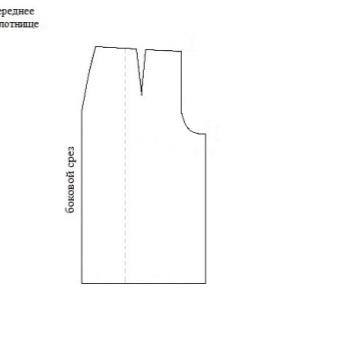
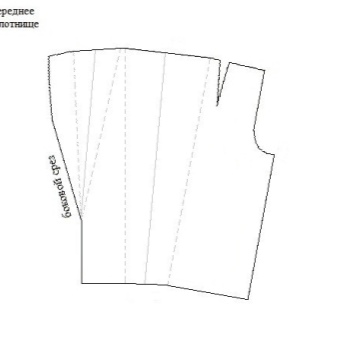
Brief technology of tailoring a culott with a smell:
- Open the culottes on the fabric, cut. Sewing of the product begins: the darts are swept away and sewn up on the machine, the seams are ironed. Step slices are swept away, and allowances are ironed.
- Lay all the necessary folds on the front panel. So that the folds do not move, you can fix them with pins. Folds can also be ironed and secured with large stitches. On the fabric itself, folds can be outlined in chalk or snares.
- A secret zipper is sewn into the back panel in a stepped cut. The line is laid as close as possible to the zipper teeth so that the zipper braid is not visible on the front side.
- Before you lay any machine stitch, see if all the folds are made correctly.
- Next are the usual steps for sewing culottes.
- Attention! The buttonhole on the belt will be at the back.
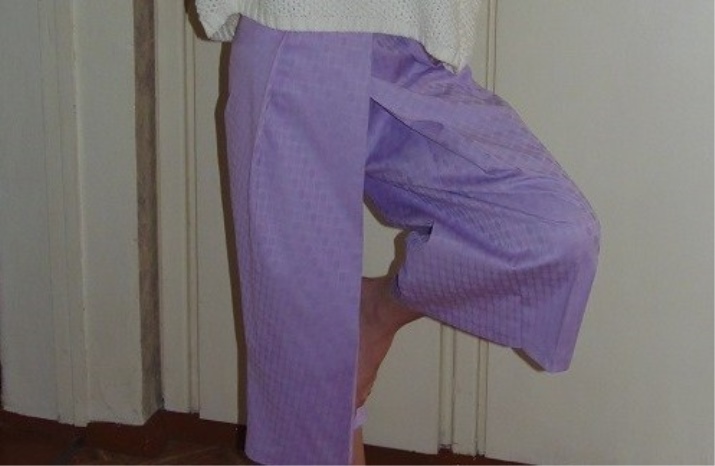
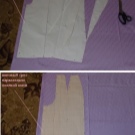
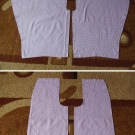
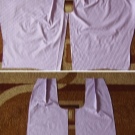
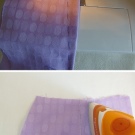
Then the final wet-heat treatment of the product is carried out. Add to it a voluminous sweater and voila - the wraparound skirt is ready!
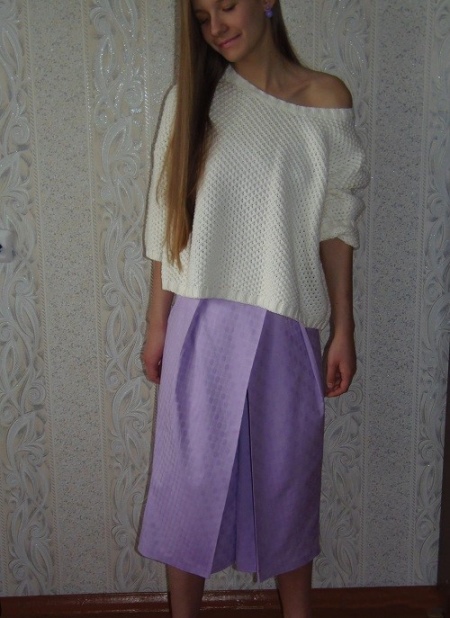
Pattern skirt pants - a detailed video right now.










